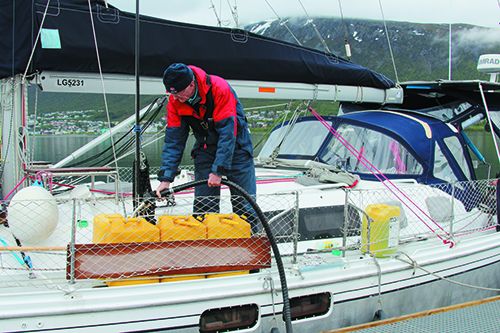
Fuel Additives in Europe
It was interesting to read your fuel additive tests (see “Are Copper, Zinc, and Brass Mucking Up Our Fuel?, PS December 2019) and about potential effects of copper in fuels. Though long being established as a potential issue, this may be a problem only in some areas around the world. In Europe, the EN 590 standard for diesel fuel and the EN 228 standard for petrol/Mogas tolerate only a little copper effect, hence this subject hasn’t made a lot of noise here. I view fuel additives in general as of little use, given that nearly all fuel additive packages to be applied by customers (except for biocides) are rendered unwanted or not recommended by the engine manufacturers. At least, that is the case in Europe.
Lutz Von Meyerink
Saturn, Ohlson 38
Hamburg, Germany
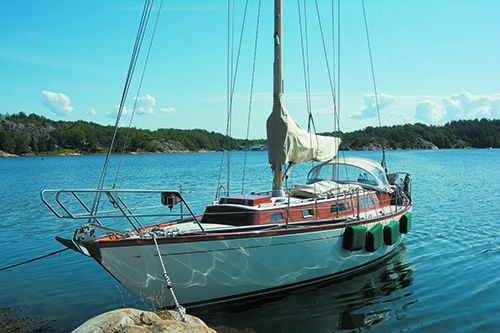
next adventure in the Baltic Sea.
Additives are a touchy subject in the U.S. because no existing standard exists, and it doesn’t appear like manufacturers are eager to have one established. Which is a shame, because standards bring credibility to an industry, and can liberate research and development departments to
explore ways to truly innovate.
The specter of increased costs as bad side effect of regulation is also frequently inaccurate. Standards can create a level playing field for multiple competitors. The consumer, of course, benefits from this, but it can make manufacturers work harder to keep market share. Thus, the resistance.
Our tech editor Drew Frye attempted to help the additive industry develop an ASTM standard for marine additives to no avail. In our view, this standard is long overdue. Not only is there no quantifiable benefit of using some fuel additives we’ve tested, some of them can actually do harm. This is especially true in cases in which the boater is prone to believing more is better.
In our view, additives should only be used to address specific problems—vague promise of a boost in performance or fuel economy doesn’t cut it. We do support the use of biocide when appropriate, but only at the recommended dose. If the bug contamination is bad, we always recommend cleaning the entire system first, because when the bugs die they will slough off and clog everything.
If fuel system corrosion is noted, a corrosion inhibitor makes sense. But willy nilly use of so-called miracle additives to “fix” a tired engine, or fulfill some general expectation of longer life or better performance can do more harm than good.
Salt Water and Sunglasses
Regarding your recent report on sunglass warranties (see “Boating Eyewear Guarantee,” PS June 2017), the most important thing is whether the coating in the lens is dissolved by the salt water. Some aren’t, but lots are. I’ve had otherwise great sunglasses ruined by a single day on the salt water, so that’s by far the most important factor in choosing glasses for the ocean. It may have something to do with the salt drying on the lenses; perhaps it could be avoided if rinsed immediately in fresh water. We all know how corrosive salt water can be, but those proprietary coatings that make the glasses look so cool are alarmingly fragile in salt water. It probably even varies from style to style, as the coatings vary in order to create different iridescent reflections.
As for my glasses, I had a pair of Smiths (a now non-existent model with replaceable lenses) and a recent pair of Goodr glasses get destroyed by salt-water exposure. The Smiths were expensive and should have done better for the price. However, the Goodr are so cheap ($25 each) that I just bought a new pair and didn’t take them on the water again.
Matt Holmes
Emeryville, CA
Regarding those coatings. You can find our technical review of certain shades of lenses, in a sidebar article accompanying our last big eyewear test (See PS July 2009, Practical Sailor Tests Polarized Sunglasses).

While most of us are hopefully out sailing this summer, we know that many sailors are busy with system upgrades, do-it-yourself projects, and the usual marine maintenance adventures. Here are some archive articles we think will help you tick off the tasks on your to-do list.

SAILS & HARDWARE
In the market for a new mainsail or hardware? Check out the August 2011 article on how to choose a new cruising main and the June 2013 review of mainsheet tackle. For hardware seekers, we recommend the test reports on ratchet blocks (May 2009), snatch blocks (August 2008 and August 2007), and rope clutches (March 2009, June 2009, and November 2014). In August 2009, we looked at genoa furlers, and in October 2015, we compared stanchion-mounted fairleads for roller furling gear. You’ll find these articles and more in our three-part ebook series, “A Look at Sails,” which is available at www.practical-sailor.com/books.
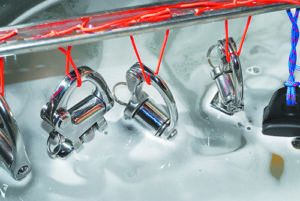
DO-IT-YOURSELF
For the DIYer, we have a slew of possible spring projects worthy of your time. Cruisers will want to look into the trysail-track refit report (May 2012) and the blog post on how to build your own custom medical kit (Practical Sailor, July 2014).
For the maintenance-minded, there’s a comprehensive look at gelcoat restoration (Inside Practical Sailor blog, Sept.13, 2017) and articles on DIY blister repair (February 2011) and re-doing your teak decks (June 2011).
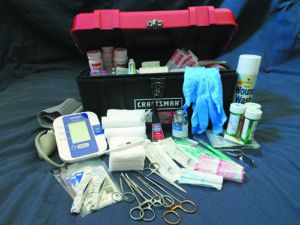
MAINTENANCE
Wondering what the best products are for those spring-summer cleaning jobs? Be sure to read our test reports on boat soaps (January 2013), waterline stain removers (April 2014 and November 2007), isinglass/clear-vinyl cleaners and protectors (May 2014 and March 2009), and hull waxes and polishes (Inside Practical Sailor blog May 12, 2015 and July 2014 PS issue).
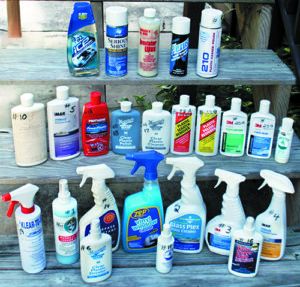
ANCHORING EBOOK
Our four-volume ebook series on anchoring continues to be one of the most popular downloadable ebooks in our library. “Anchoring—The Complete Series,” is a multi-part ebook series that offers over 15 years of comprehensive anchor test reports in one publication. Find it at www.practical-sailor.com/books.

Kudos to Maui Jim Guarantee
I have been using Maui Jim sunglasses—particularly on the water. I was extremely upset when I thought I lost them a few years back. Turns out I dropped them in the driveway. And by the look of them, I drove over them and completely crushed them. So I took them in to the shop where I bought them and said I wanted to buy a replacement pair just like these. Turns out not only were they still under warranty, they replaced them no questions asked. I bought an extra set just because I liked them and didn’t want to be in the same situation again.
Michael Bancroft
via PS Online
Maui Jim Lens Replacement
While I’ve not tried to do any warranty/repair with glasses from the above mentioned manufacturers, I have done so with several pairs of Maui Jims. Their warranty/repair services are excellent. Most of the time I had scratched the lens (my fault) and sent them in for lens replacement, it’s around $75. They came back in like new condition and turn around was very short.
Bill Elliot
via PS Online
Mystery Oil for Heads
Several years ago a representative for one of the manufacturers recommended adding a few drops of Marvel Mystery Oil into the toilet bowl from time to time to lubricate the pump and valves. Have you ever heard this, and is it satisfactory?
Rob Johnson
Tempus Fugit, Rival 34
Monteo, North Carolina

next adventure in the Baltic Sea.
Although we’ve not tested this. PS Technical Editor Drew Frye doubts it would be a good thing for your head. Based on his experience, he believes you’ll have scum building up on the walls of your waste lines and holding tank as the oily solution builds up in the system.
The only recommended use of lubricants in a typical piston-pump head is to lubricate the pump shaft. Some manufacturers do recommend lubricating the pump body once a year by pumping silicone or grease through the system. Raritan specifies Super Lube Synthetic Grease, and Jabsco specifies Vaseline.
For more a complete discussion of head maintenance, see Peggy Hall’s updated Get Rid of Boat Odors (Seaworthy Press, $23). Another great reference is our own Practical Sailor Marine Sanitation E-book (www.practical-sailor.com/products), which includes our testing of every product you’ll find in the contemporary marine system, including heads (electric and manual), sanitation hoses, holding tanks, and odor control products.

of Raritan PHII toilet after one year of us illustrates how scale can build up in the valves and cylinders (see Descaling Solutions for Boats, PS August 2017).
Paint versus Varnish
Regarding your comprehensive report on wood finishes (see PS December 2009, “Exposure Test Results: Varnishes, Teak Oils, and Other Exterior Wood Coatings”), I recently committed the ultimate sin: I painted my teak toerails with gray Interlux Brightside one-part polyurethane paint. I had become disillusioned after the poor performance of varnish and Cetol only holding up for a couple of seasons, and I have better things to do with my time. I would be curious for Practical Sailor to do a study on the longevity of paint over teak and which brands are best, then compare said results to the best of your wood coatings tests. I know paint dramatically changes the look of the boat, but my wife and I think it looks pretty nice and gives the boat a clean, modern appearance.
Thom Ehlman
Via PS Online
Painting over varnished wood is hardly a sin in our book. The natural colors and patterns of wood hold a special place in the mind’s eye, but in the end, beauty is in the eye of the beholder. If a painted handrails makes you happier, go for it. It is certainly not hurting anyone. Cruising sailors often paint over their brightwork to reduce maintenance when they are “out there,” but you can also just let it go silver (see the Inside PS blog post “The Norwegian Approach to Teak Deck Care”). Paint is more tolerant of weathering and easier to touch up, and there is always plenty of other work to be done on a cruising boat that is on the move.
Unless you are fully committed to paint, we would recommend sticking with single-part formulas. The editor used high-quality semi-gloss enamel house paint on the topsides (western cedar) his antique wooden gaffer, but as you point out, glossy paints like Brightside will maintain an appearance that is more “modern.”
We’ve conducted a number of topside coating tests that would help inform your choice of products (see PS December 2012, “Topside Paint Endurance Test, 3-Year Check-up”). Although the tests focus on “marine” coatings, they also include conventional house paints.
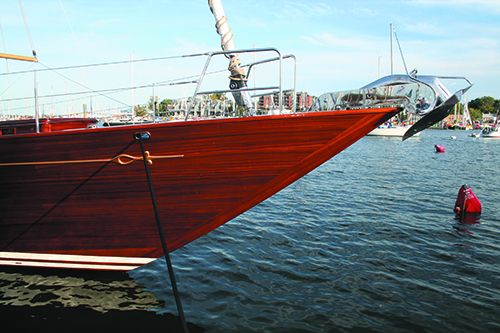
Beautifully maintained brightwork entails extra work, but it can be a shoestring sailor’s calling card to potential work on megayachts as you move from place to place. Of course, the opposite is true as well. Having a boat that needs its varnish refreshed while cruising also gives you the opportunity to connect with local residents and support the local economy by hiring someone to do the refinishing. It seems like there’s a talented varnish pro in even the most far-flung port.
For those who are used to keeping strict maintenance schedule, varnish is not such a burden if you stay ahead of the game. Simple acts like rinsing off salt crystals, touching up dings, and regular top coats can go a long way to ensuring a beautiful finish.
Practical Sailor welcomes reader comments and questions. Send email & reader photography (digital .jpg 1MB or greater) to [email protected]; include your name, homeport, boat type, and boat name. Send any broken gear samples to Practical Sailor, 1600 Bayshore Rd., Nokomis, FL 34275

of boats, knot-tying, and life.
Few sailors have so well embodied the art of being a sailor than renowned rigger and longtime PS contributor Brion Toss, who died of complications from cancer on June 6 at the age of 69.
Brion dedicated his life to the art of rope, spars, and wire. His seminal book “The Rigger’s Apprentice” continues to be a favorite among cruising sailors today. Beyond his broad knowledge of sailing lore and his love for rigging puzzles, I’ll best remember Brion for his generosity and great sense of humor—puns and all.
Throughout his storied career as a rigger, Brion developed a rare ability to both inspire and inform. When you walked out of a Brion Toss seminar at Northwest Maritime Center, the outstanding educational center that he helped anchor in his hometown, you felt like you learned as much about life as you did about boats. Brion’s captivating presentations—some of which were later adapted into articles for Practical Sailor—were sprinkled with witty reminders that humans are funny, far-from-perfect beings, and the few who believe they are perfect sure aren’t very good at demonstrating it.
I got the feeling Brion could see what few people ever can. And after re-reading his work for Practical Sailor, I have my own theory why. Rigging problems demand near-perfect solutions, but the world is terribly imperfect place. Forever evolving as a rigger, Brion found a beautiful, good humored way to inhabit these seemingly contradictory worlds.
When he surveyed a rig from the deck, you could almost see his mind absorb the perfect world of angles and forces that kept the spar upright, and then you’d hear him laugh when he found the undersized shackle or toggle that someone had inserted and put the entire structure in jeopardy.
As he concluded in the introduction to Falling, a marvelous collection of essays he completed shortly before he died: “We are all dealing with gravity.” Brion dealt with it as an expert, better than any rigger I’ve met. He showed me how a joyful appreciation of tiny details and an eye for “following the load” can lift us to a higher plane, a place where even gravity isn’t a such a downer.
We miss you friend—puns and all.









































